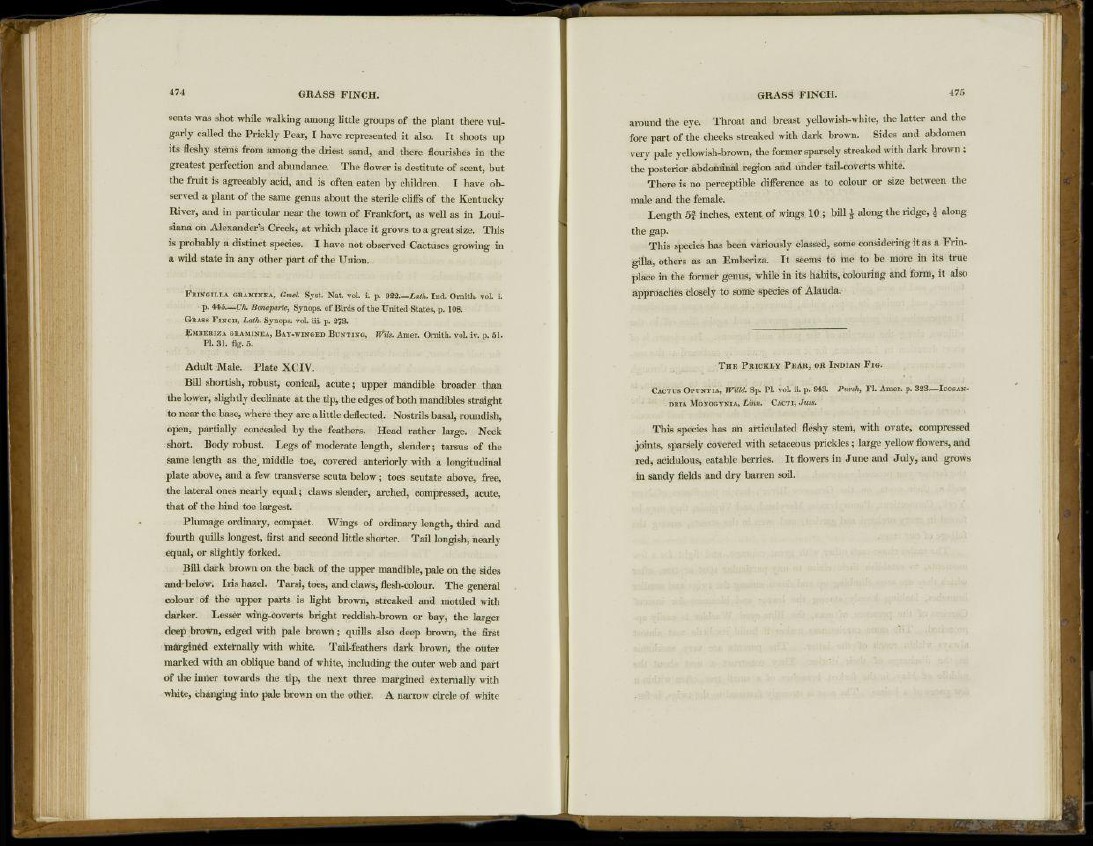
474 GRASS FINCH.
sents was shot while walking among little groups of the plant there vulgarly
called the Prickly Pear, I have represented it also. It shoots up
its fleshy stems from among the driest sand, and there flourishes in the
greatest perfection and abundance. The flower is destitute of scent, but
the fruit is agreeably acid, and is often eaten by children. I have observed
a plant of the same genus about the sterile cliffs of the Kentucky
River, and in particular near the town of Frankfort, as well as in Louisiana
on Alexander's Creek, at which place it grows to a great size. This
is probably a distinct species. I have not observed Cactuses growing in
a wild state in any other part of the Union.
FRINGILLA GRAMINEA, Gmel. Syst. Nat. vol. i. p. 922.—Lath. Ind. Ornith. vol. i.
p. 445.—Ch. Bonaparte, Synops. of Birds of the United States, p. 108.
GRASS FINCH, Lath. Synops. vol. iii. p. 273.
EMBERIZA GRAMINEA, BAY-WINGED BUNTING, Wits. Amer. Ornith. vol. iv. p. 5 1 .
PI. 31. fig. 5.
Adult Male. Plate XCIV.
Bill shortish, robust, conical, acute; upper mandible broader than
the lower, slightly declinate at the tip, the edges of both mandibles straight
to near the base, where they are a little deflected. Nostrils basal, roundish,
open, partially concealed by the feathers. Head rather large. Neck
short. Body robust. Legs of moderate length, slender; tarsus of the
same length as the^ middle toe, covered anteriorly with a longitudinal
plate above, and a few transverse scuta below ; toes scutate above, free,
the lateral ones nearly equal; claws slender, arched, compressed, acute,
that of the hind toe largest.
Plumage ordinary, compact. Wings of ordinary length, third and
fourth quills longest, first and second little shorter. Tail longish, nearly
equal, or slightly forked.
Bill dark brown on the back of the upper mandible, pale on the sides
and- below. Iris hazel. Tarsi, toes, and claws, flesh-colour. The general
colour of the upper parts is light brown, streaked and mottled with
darker. Lesser wing-Coverts bright reddish-brown or bay, the larger
deep brown, edged with pale brown ; quills also deep brown, the first
margined externally with white. Tail-feathers dark brown, the outer
marked with an oblique band of white, including the outer web and part
of the inner towards the tip, the next three margined externally with
white, changing into pale brown on the other. A narrow circle of white
GRASS FINCH. 475
around the eye. Throat and breast yellowish-white, the latter and the
fore part of the cheeks streaked with dark brown. Sides and abdomen
very pale yellowish-brown, the former sparsely streaked with dark brown ;
the posterior abdominal region and under tail-coverts white.
There is no perceptible difference as to colour or size between the
male and the female.
Length 5f inches, extent of wings 10 ; bill £ along the ridge, | along
the gap.
This species has been variously classed, some considering it as a Fringilla,
others as an Emberiza. It seems to me to be more in its true
place in the former genus, while in its habits, colouring and form, it also
approaches closely to some species of Alauda.
THE PRICKLY PEAR, OR INDIAN FIG.
CACTUS OPUNTIA, Willd. Sp. PI. vol. ii. p. 943. Pursh, Fl. Amer. p. 323.—ICOSANDRIA
MONOGYNIA, Linn. CACTI, JUSS.
This species has an articulated fleshy stem, with ovate, compressed
joints, sparsely covered with setaceous prickles; large yellow flowers, and
red, acidulous, eatable berries. It flowers in June and July, and grows
in sandy fields and dry barren soil.